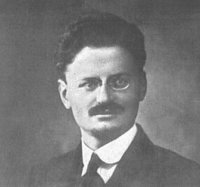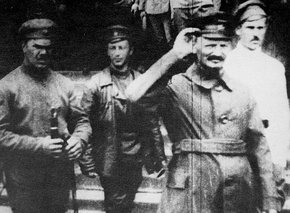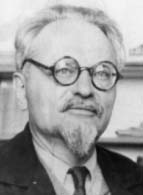Leon Trotsky
|
|
Leon Davidovich Trotsky (Russian: Лев Давидович Троцкий; also transliterated Leo, Lev, Trotskii, Trotski, Trotskij and Trotzky ) (October 26 (O.S.) = November 7 (N.S.), 1879 – August 21, 1940), born Lev Davidovich Bronstein (Лев Давидович Бронштейн), was a Bolshevik revolutionary and Marxist intellectual. He was an influential politician in the early Soviet Union, first as People's Commissar for Foreign Affairs and then as the founder and commander of the Red Army and People's Commissar of War. He was also a founding member of the Politburo. Following a power struggle with Joseph Stalin in the 1920s, Trotsky was expelled from the Communist Party and deported from the Soviet Union; he was later murdered in Mexico by Ramón Mercader, a Soviet agent. Trotsky's ideas form the basis of the communist theory of Trotskyism.
He is alluded in the popular novel "Animal Farm" by George Orwell – whose characters are animal versions of real people during the Russian Revolution – as Snowball the pig.
| Contents [hide] |
Early days
His date of birth in the Gregorian calendar is November 7 – the same day as the Soviet revolution of 1917. Since the Julian calendar was replaced in 1918, his date of death is that of the Gregorian calendar. He was born in Yanovka, Kherson Province, Ukraine, the son of a wealthy farmer, David Bronstein, a Jewish colonist. He was sent at age 8 by his father to Odessa for education and was transferred to Nikolayev six years later.
Revolutionary activity
Leon_Trotsky_-_Okhranka_mugshot.gif
He was first introduced to Marxism in 1896, while at school in Nikolayev studying mathematics. He was first arrested in 1898 while working as an organizer for the South Russian Workers' Union. He was sentenced to two years in prison. During this time, he married his first wife, Aleksandra Sokolovskaya. In 1900 he was sentenced to four years in exile in Siberia, where his first two daughters were born. He escaped from Siberia, taking the name Trotsky from a former jailer in Odessa, and proceeded to London to join Vladimir Lenin, then managing editor of the Russian Social Democratic Labour Party newspaper Iskra.
He attended the 2nd Congress of the RSDLP in London in the summer of 1903, and in the internal dispute which split the party, sided with the Mensheviks against Lenin. Although his allegiance to the Mensheviks was short-lived, the damage to his relationship with Lenin lasted for the next 14 years. Also led the Mezhraiontsy.
By 1905, he had returned to Russia. He was elected Chairman of the St. Petersburg Soviet of Workers' Deputies. His involvement in the October general strike and his support for that armed rebellion led to his conviction and sentence to exile for life. In January 1907, he escaped en route to exile and once again made his way to London, where he attended the 5th Congress of the RSDLP. In October, he moved to Vienna, where he edited a Social Democratic paper called Pravda, which was smuggled into Russia. It was one of numerous short-lived revolutionary Pravdas and had no connection with the official paper of the CPSU (see Pravda).
As war approached, Trotsky moved to neutral Switzerland, then to France. He was deported from France and was living in New York City when the February 1917 Russian Revolution removed Tsar Nicholas II. He left New York in March aboard the S.S. Christiania Fiord but his ship was intercepted by British naval officials in Halifax, Nova Scotia. He and five companions were arrested and millions of dollars in gold were seized from the ship. He finally made his way back to Russia in May of that year. Upon his return, he was a supporter of the Bolshevik position, formally joining the faction a few months later. Trotsky was actively involved in efforts to overthrow the Provisional Government headed by Aleksandr Kerensky and was elected to the leadership of the Petrograd Soviet.
After the Russian Revolution
After the Bolsheviks came to power, he became the People's Commissar for Foreign Affairs with the major goal of negotiating peace with Germany and her allies. But his withdrawal from the talks (February 10, 1918) provoked a German invasion (February 18), forcing the Soviet regime to sign the highly disadvantageous Treaty of Brest-Litovsk on March 3. Trotsky subsequently resigned his diplomatic position. In March, 1918 he was appointed People's Commissar of Army and Fleet Affairs (Нарком по военным и морским делам, Нарком армии и флота) (1918-1925). In September 1918 he was appointed Chairman of Revolutionary Military Council (Реввоенсовет) of the Republic.
As founder and commander of the Red Army, he was largely responsible for their success over the White Army and victory in the lengthy and violent Russian Civil War.
In March 1921 he organised and directed the suppression of the Kronstadt Rebellion, famous as the last major revolt against Bolshevik rule and an important event in the history of working class struggle.
With the illness and death of Lenin, Joseph Stalin was able to consolidate his control of the Party and the government. At this point, Trotsky was unable or unwilling to actively oppose Stalin. By remaining silent at the Twelfth Party Congress in 1923, particularly on the issue of the suppressed Testament of Lenin that called for Stalin's removal, Trotsky lost his last real opportunity to oppose Stalin, who, along with Lev Kamenev and Grigory Zinoviev, was able to take control of the Party. Trotsky and his supporters founded the Left Opposition, which fought within the Communist Party for several years against Stalin's platform and leadership.
Trotsky put forward the theory of 'Permanent Revolution' and an internationalist perspective, which stood in stark contrast to Stalin's policy of building 'Socialism in One Country'. He also put forward an argument for rapid industrialization of the economy and abandonment of the New Economic Policy while Stalin, allied with Bukharin, argued for gradual industrialization and retention of the NEP. This ideological division provided much of the intellectual basis for the political divide between Trotsky and Stalin, which culminated on November 12, 1927 when he was expelled from the Soviet Communist Party (leaving Stalin with undisputed control of the Soviet Union). He was exiled to Alma Ata (now in Kazakhstan) on January 31, 1928. He was expelled from the Soviet Union in 1929.
Following Trotsky's defeat, Stalin turned against Bukharin and appropriated much of Trotsky's domestic economic policy, although he implemented it in a manner criticised for being overly violent and authoritarian.
TrotskyLastOffice.jpg
In exile
Trotsky was deported in 1928. His first station in exile was the Turkish island of Prinkipo, where he stayed four years. In 1933 he was offered asylum in France by Daladier. He stayed first at Royan, then at Barbizon. He was not allowed to visit Paris. In 1935 it was implied to him that he was no longer welcome in France and, after weighting alternatives, he moved to Norway, where he was a guest of Konrad Knudsen near Oslo. After two years, allegedly under influence from the Soviet Union, he was put under house arrest. After consultations with the Norwegian officials, his transfer to Mexico on a freighter was arranged.
In Mexico, he lived at one point at the home of the painter Diego Rivera, and at another at that of Frida Kahlo. He was a prolific writer penning several key works including his History of the Russian Revolution (http://www.marxists.org/archive/trotsky/works/1930-hrr/index.htm) (1930) and The Revolution Betrayed (http://www.marxists.org/archive/trotsky/works/1936-rev/index.htm) (1936), a critique of the Soviet Union under Stalinism. Trotsky argued that the Soviet state had become a degenerated workers' state controlled by an undemocratic bureaucracy, which would eventually either be overthrown via a second proletarian socialist revolution or degenerate to the point where it reverts to capitalism (as it has today). While in Mexico, Trotsky also worked closely with James P. Cannon, Joseph Hansen and Farrell Dobbs of the Socialist Workers Party of the United States. Cannon, a long time leading member of the American communist movement, had been supporting Trotsky in the struggle against Stalinism since it started.
In 1938, Trotsky and his supporters founded an international Marxist organization, the Fourth International, which was intended to be a Trotskyist alternative to the Stalinist Third International. Trotsky eventually quarreled with Rivera and in 1939 moved into his own residence in Coyoacán (a neighborhood in Mexico City). On May 24, 1940, he survived a raid on his home by alleged Stalinist assassins. Later, on August 20, 1940, Trotsky was successfully attacked in his home by a Stalinist agent, Ramón Mercader, who drove the pick of an ice axe (whose shaft had been drastically shortened in order to allow the weapon to be concealed), into Trotsky's skull. The blow was poorly delivered, however, and failed to kill Trotsky instantly as Mercader had intended. Witnesses have stated that Trotsky let out a blood-curdling cry and began struggling fiercely with Mercader. Hearing the commotion, Trotsky's bodyguards burst into the room and nearly killed Mercader, but Trotsky stopped them, shouting, "Do not kill him! This man has a story to tell." Trotsky died the next day.
TrotskyGrave.jpg
Mercader later testified at his trial: "I laid my raincoat on the table in such a way as to be able to remove the ice axe which was in the pocket. I decided not to miss the wonderful opportunity that presented itself. The moment Trotsky began reading the article, he gave me my chance; I took out the ice axe from the raincoat, gripped it in my hand and, with my eyes closed, dealt him a terrible blow on the head."
Trotsky's house in Coyoacán was preserved in much the same condition as it was on the day of the assassination and is now a museum. His grave is located on its grounds.
Trotsky was never formally rehabilitated by the Soviet government, despite the Glasnost-era rehabilitation of most other Old Bolsheviks killed during the Great Purges.
Theory
Trotskyism
Main article: Trotskyism.
Permanent Revolution
Main article: Permanent Revolution.
Transitional Program
Main article: Transitional Program.
Related articles
- Stalinism
- History of Russia, a series of articles.
- Labor army
- David Ives wrote a satirical one-act play entitled Variations on the Death of Trotsky, included in the collection All in the Timing
References
- The Modern Encyclopedia of Russian and Soviet History, Volume 39, published by Academic International Press
- Trotsky, the Eternal Revolutionary by Dimitri Volkogonov published by the Free Press in 1996.
- The Mind of an Assassin, by Isaac Don Levine, New York: New American Library/Signet Book, 1960.
- Isaac Deutscher wrote a largely sympathetic biography of Trotsky, in three volumes, titled Trotsky: The Prophet Armed (1954), Trotsky: The Prophet Unarmed (1959), and Trotsky: The Prophet Outcast (1963). Also see his book Ironies of History (1966).
- Dave Renton - Trotsky (2004)
External links
Template:WikiquoteTemplate:Commons
- 'Ice-pick that killed Trotsky' found in Mexico (http://www.guardian.co.uk/russia/article/0,2763,1507575,00.html) which is stained with his blood
- Trotsky archive (http://www.marxists.org/archive/trotsky/index.htm) at Marxists.org (under GFDL-license)
- FBI records relating to Trotsky's murder (http://foia.fbi.gov/foiaindex/trotsky.htm)
- Writings and Marxist analysis (http://www.trotsky.net)
- Forty Years Since Leon Trotsky’s Assassination (http://www.marxist.net/trotsky/life/life.htm) by Lyn Walsh
- Lenin and Trotsky - What they Really Stood For (http://www.marxist.com/LeninAndTrotsky/) by Alan Woods and Ted Grant
- Trotsky's Relevance Today (http://www.socialistworld.net/index2.html?/eng/2000/05d.html) by Peter Taaffe
- Impressions of Soviet Russia, by John Dewey (http://geocities.com/deweytextsonline/isr.htm)
- "Trotsky admits aid to Japanese imperialism" and other criticism on Trotsky (http://www.etext.org/Politics/MIM/classics/trotsky.html)
- Trotsky Biography (http://www.spartacus.schoolnet.co.uk/RUStrotsky.htm) From Spartacus Educational
- The committee for a workers' international (cwi) (http://www.socialistworld.net/)
- marxist.net (http://www.marxist.net/)
- The World Socialist Website Political Organ of the ICFI (http://www.wsws.org)
- The Lubitz TrotskyanaNet, dealing with Leon Trotsky, Trotskyism and Trotskyists (http://www.trotskyana.net)
Template:Russian Foreign Ministersbg:Лев Троцки ca:Lev Trotsky da:Lev Trotskij de:Leo Trotzki et:Lev Trotski es:Lev Trotski eo:Lev TROCKIJ fr:Léon Trotsky id:Lev Trotski it:Leon Trotsky he:לאון טרוצקי hu:Lev Davidovics Trockij nl:Leon Trotski ja:レフ・トロツキー nb:Lev Trotskij nn:Lev Trotskij pl:Lew Trocki pt:Leon Trotski ro:Lev Davidovici Troţki ru:Троцкий, Лев Давидович sl:Lev Trocki fi:Lev Trotski sv:Lev Trotskij zh:列夫·托洛茨基



